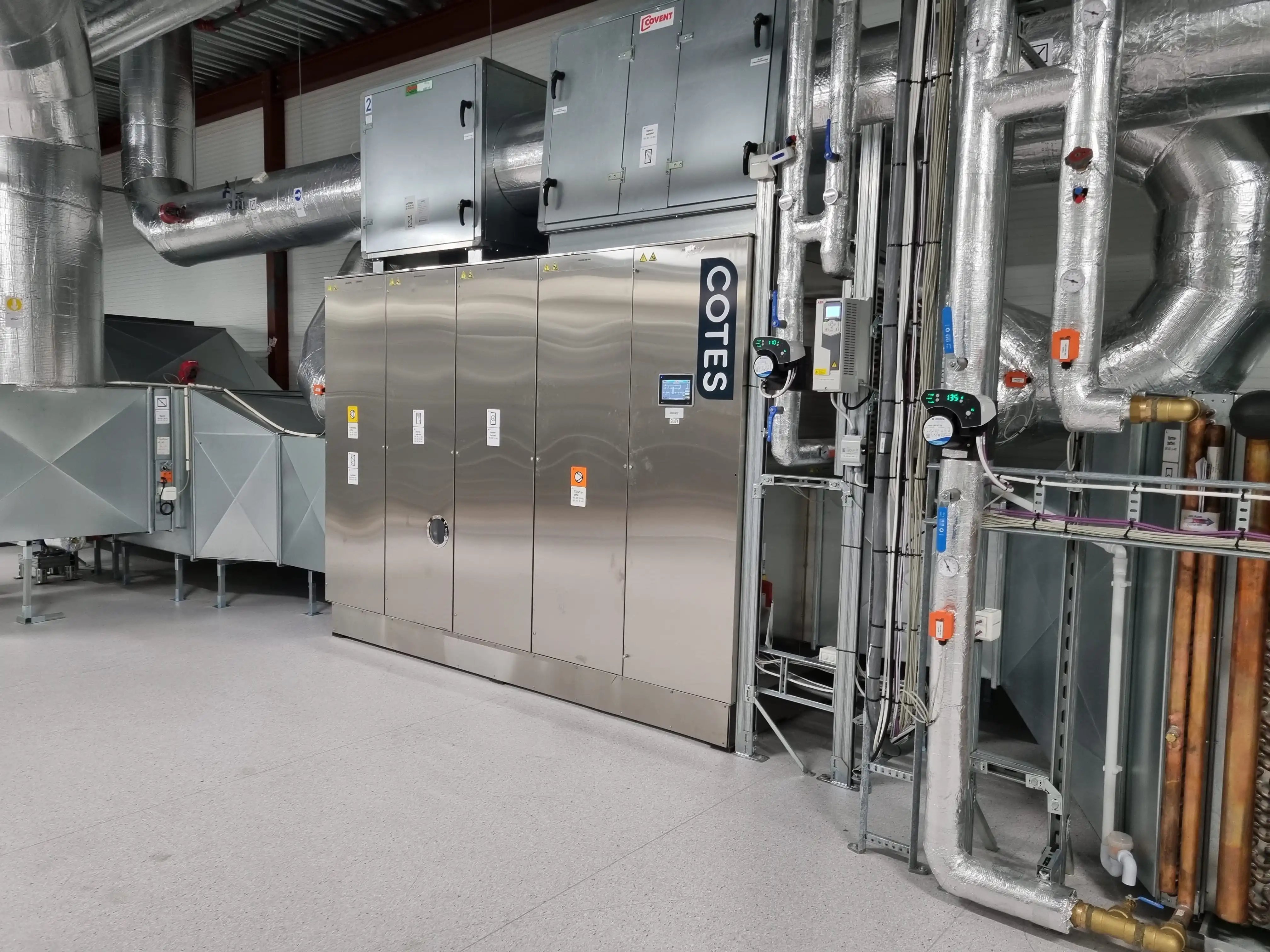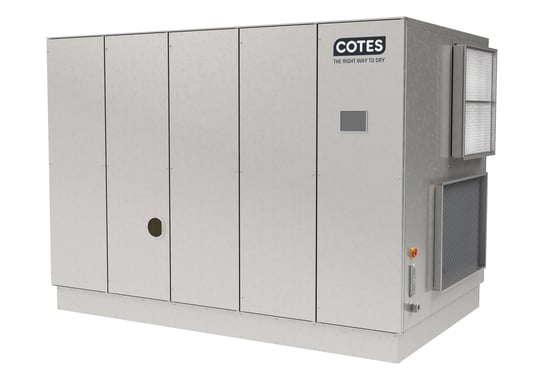In the fishing industry, the process of handling seafood requires a complex interplay of precision and care. Fish is an exceptionally perishable food, and any missteps in handling and processing can lead to deterioration and loss of product quality or even spoilage. One often overlooked but critical aspect of this process is the dehumidification of processing environments which is essential for food protection and safety in many branches of the food and beverage industry.
THE FISH-HANDLING PROCESS
Fish processing typically commences as soon as the catch is brought ashore. The fish then undergoes gutting and filleting into different cuts depending on the final product. The process is finalised by washing, glazing, and packaging. To ensure that the highest quality and safety requirements are fulfilled, each step requires precision and skill. Any mistakes in this carefully planned series can jeopardize the final product.
The high water content of fish and the fragile nature of its flesh make it particularly vulnerable to spoilage. The texture, flavour, and overall quality of fish can be negatively impacted by exposure to impurities, temperature changes, or incorrect handling. These hazards also pose risks to food safety. Therefore, it is critical to ensure a clean and regulated atmosphere throughout the entire processing sequence, from gutting to packaging. Additionally, to guarantee that the fish reaches customers in the best possible condition, it is imperative to minimise moisture accumulation and uphold appropriate storage conditions, including temperature and humidity.
CHALLENGES CAUSED BY IMPROPER FISH HANDLING
The fishing industry encounters challenges in location with variable seasons and weather patterns. Fluctuations in temperature and humidity throughout the year can lead to humidity issues during processing and storage, negatively impacting the safety and quality of the final product. For instance, excessive humidity during the summer can cause condensation problems, and very low temperatures during the winter months can cause ice to accumulate. Additionally, the following humidity-related issues can arise:
- Deterioration of freshness, resulting in changes in texture and flavour, and potentially causing spoilage
- Growth of bacteria, mould, and other microorganisms on the product and on surfaces or structures within the facility
- Difficulty maintaining consistent quality levels due to oxidation of the fish, leading to rancidity and other unwanted flavours
- Ice buildup in refrigerators and freezers where fish is stored
- Corrosion of equipment or structures in the facility
- Safety hazards that, in the worst case, could result in food poisoning or other serious health concerns
A controlled environment ensures that fish products can be stored for longer periods while maintaining quality and safety. This requires a delicate balance that necessitates constant monitoring and the implementation of technologically advanced solutions to address the natural perishability of this highly sought-after food source.
THE PURPOSE OF DEHUMIDIFICATION IN FOOD PROCESSING
Dehumidification solutions offer a means of addressing seasonal challenges and atmospheric fluctuations for the fishing industry. By controlling humidity levels, these solutions provide stable environmental conditions regardless of external weather patterns.
Controlling humidity reduces the possibility of ice accumulation, which can damage processing machinery and lower the quality of the final product. It also prevents the formation of condensation, lowering the chance of slip hazards and equipment corrosion. Most importantly, humidity control supports food safety by inhibiting the growth of harmful bacteria. Furthermore, dehumidification in storage facilities prevents freezer burn, ensuring that fish products keep their flavour and texture for longer.
By maintaining optimal humidity levels and preventing moisture-related problems, dehumidification contributes to achieving and maintaining the high regulatory standards required by this industry. The right dry-air solution is a vital element in the industry's commitment to delivering safe, high-quality seafood products to consumers.
CASE STORY: PROTECTING A SALMON PROCESSING FACILITY FROM UNWANTED HUMIDITY
Cotes Norwegian partner, F-Tech, supplied a salmon processing facility with a Cotes Flexible unit to deal with the challenging conditions that naturally occur within processing fish. The conditions in such facilities are characterised by low temperatures, and excessive water resulting in humidity and condensation, which leads to numerous threads. During high-pressure washing, there are tiny water particles in the air that combine with the fish fat creating conditions in which it is harder to breathe. This could raise concerns with the Labor Inspection Authorities. Neglecting to address these issues may lead the Norwegian Food Safety Authority to close the facility.
It is therefore crucial to ensure that excess humidity is removed as efficiently as possible. This presents a challenge to facilities that process salmon as they naturally experience high condensation from the regular washing in temperatures that need to be kept between 8-12°C. A cooling coil in regular ventilation would not be sufficient to handle the moisture in these conditions. The installation of an adsorption dehumidifier proved to be the only effective solution.
THE SOLUTION
 Image: Cotes Flexible unit in the salmon processing facility
Image: Cotes Flexible unit in the salmon processing facility
F-Tech chose to supply the facility with a Cotes Flexible unit, because it is a tailor-made solution that can effectively operate under very challenging conditions. This dehumidification solution can maintain the relative humidity (RH) below 45%, which, combined with a smart solution from F-Tech, keeps the surfaces dry in all operational situations (e.g., regular production, plant cleaning, and when the plant is being dried and prepared for new production).
F-Tech explains their approach, utilising a mix of recirculated and fresh air for optimal conditions. After every production shift, the whole room and equipment are washed thoroughly. This results in a lot of water and wet surfaces, but with the installed systems the production facility is completely dry within 2 hours. This approach can be also highly relevant for other food production facilities. Cotes dehumidifiers play a key role, as they push down the dew point to -15 to -20°C. Additionally, the largest Cotes unit has the capacity to remove up to 132kg of water per hour.
"This gives us a lot of space to manage moisture inside the production room." - Odd Olav Fosso, owner and project manager at F-Tech
This strategic setup effectively manages the humidity in all operational situations meeting the client's requirements.
THE BEST DEHUMIDIFIER FOR THE JOB
Cotes Flexible dehumidifiers are designed for large-scale humidity management in conjunction with process drying – where exceptionally dry air (deep drying, high ΔX) or exceptional volumes of process air are required – ensuring effectiveness, versatility and reliability. This range of well-engineered, energy-efficient, reliable dehumidifiers is robustly built and designed for ease of use, maintenance and operation in industries like food and beverage, ice rinks, sports facilities, powder packaging lines, and industrial air supply, among others..
 Image: Cotes Flexible unit
Image: Cotes Flexible unit
Do you have issues with humidity?
If you would like to determine the right dry-air solution for your production or if you would like to explore what a custom dry-air strategy could do for your business, please reach out to one of our trusted partners near you.
